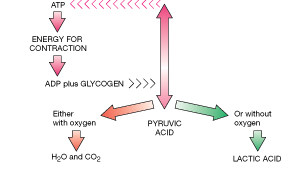After studying this section you should be able to:
- describe how ATP supplies muscles with energy
- understand the terms aerobic and anaerobic
How ATP supplies muscles with energy
Training requires a great deal of muscular exertion. This means that throughout exercise the muscles are continually contracting and relaxing. This muscular exertion requires energy. Energy comes from a substance called adenosine triphosphate (ATP) which, during exercise, breaks down to a second substance called adenosine diphosphate (ADP) and this produces energy.
The energy that is stored in ATP comes from the reaction between glucose and oxygen.
KEY POINT - ATP is stored in muscle fibres but is used up quickly.
Aerobic & anaerobic activity
Aerobic activity
If a lot of oxygen is present, then energy production is carried out aerobically. As this type of physical activity requires large amounts of oxygen, the level of work must be of low intensity, but it may continue for a long period of time.
Long distance running is an aerobic activity.
Anaerobic activity
If there is a shortage of oxygen, then energy production is carried out anaerobically. This type of physical work is usually of high intensity, lasts for a short period of time, requires a great deal of energy, but happens so fast that there is not enough time to get lots of oxygen to the muscles. The 100 m sprint is an anaerobic activity.
If anaerobic activity takes place over a long period of time, the muscles soon become exhausted. This is due to a condition called oxygen debt.
Strenuous exercise uses up all ATP stores and causes a build-up of lactic acid.
This is a toxic (poisonous) substance which causes the muscles to stop working. Lactic acid can only be removed in the presence of oxygen and upon completion of hard strenuous exercise it is essential that the oxygen debt is repaid. Large amounts of oxygen are needed for this oxygen recovery. This is why we pant after hard exercise. In this way ATP stores are replenished and lactic acid removed from the muscular system.

By establishing a suitable training threshold rate it should be possible to train effectively, while at the same time avoiding the build-up of lactic acid which could bring training to a premature end.
